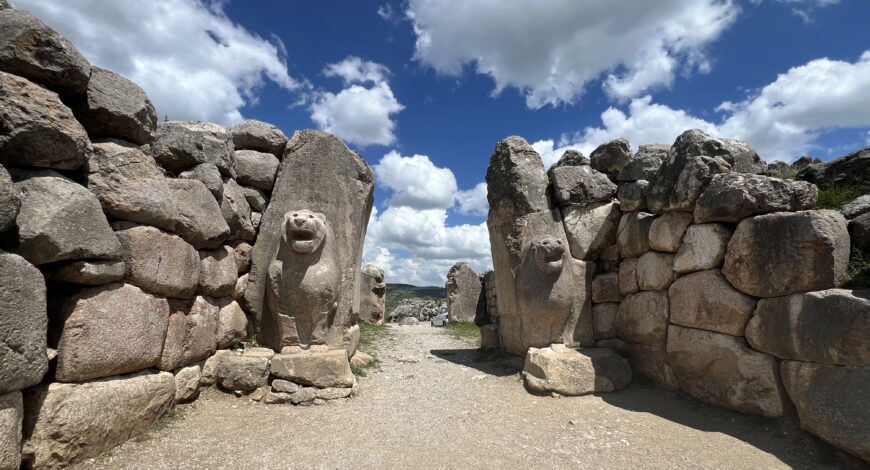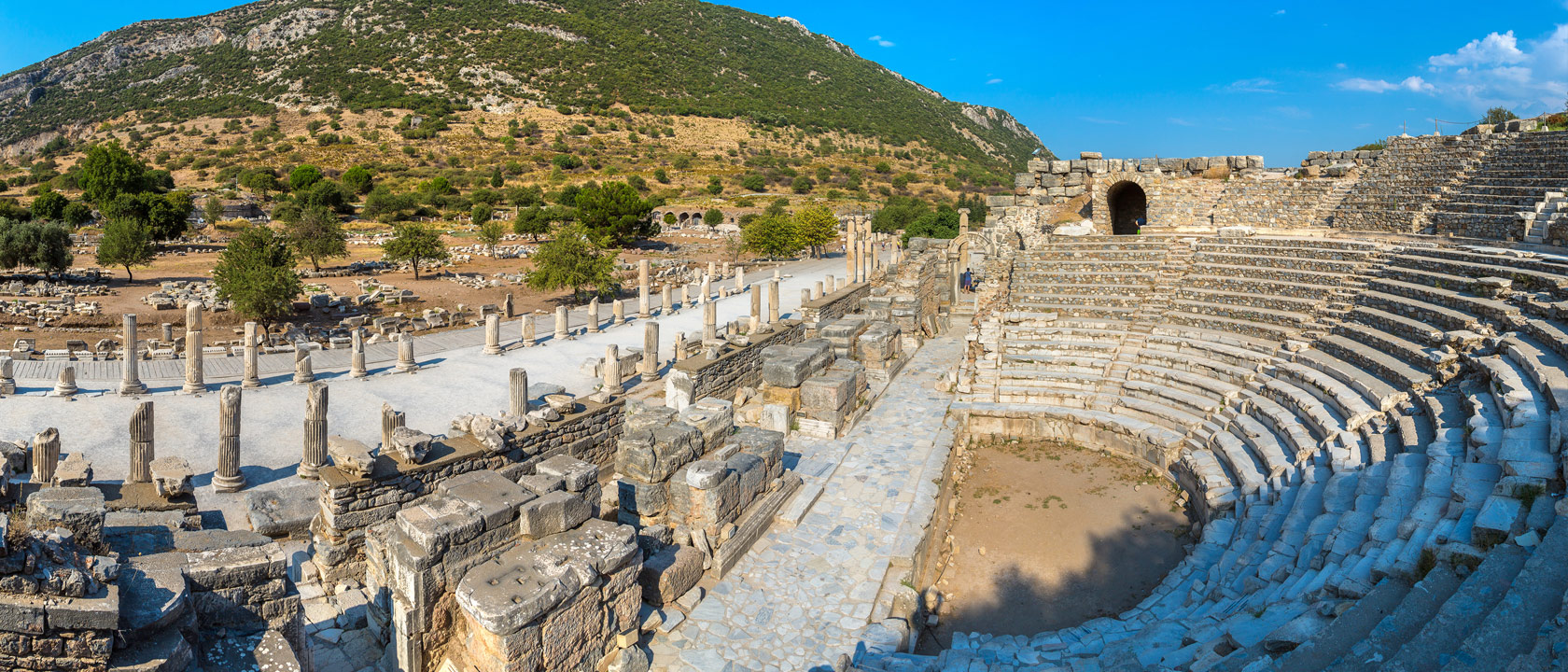The Hittites and their Capital Hattusa
by Dr Erica Hunter

The origins of this Indo-European people, who dominated Anatolian and Near Eastern history for seven centuries (Middle Bronze-Late Bronze Ages) until the sudden demise of their empire ca. 1200 BCE, are shrouded in uncertainty. Rather than a violent conquest of Anatolia, the Hittites seem to have peacefully infiltrated the region, mingling with the indigenous population, replacing the local dialect (Hattian) with their own language, and gaining political and cultural supremacy.
The Rise of the Hittites
The half-legendary ‘Kings of Kussara’, the ancestors of King Pithana and his son Anitta, were named by Hittite records as the founders of the dynasty. That Hittite rulers were already dwelling at Kanesh (today Kültepe) ca. 1750 BCE is suggested by the discovery of a bronze spearhead inscribed with a king of this name. A century later, ca. 1650 BCE, the Hittite capital at Boğazkale, ancient Hattusa, within the great loop of Kızılırmak River (the classical Halys but called Maraššantiya by the Hittites) was established by King Labarna II. Together with his successors Hattusilis I and Mursili I, he established Hittite dominion over Anatolia and northern Syria. In 1600 BCE, Mursili I conquered Aleppo and then sent a military expedition against Babylon, where he brought the Old Babylonian dynasty of Hammurabi to an end. However, on his return to Hattusa, Mursili I was murdered in a dynastic dispute, and the Old Kingdom entered into a long period of decline.
 The New Kingdom arose ca. 1425 BCE in the Late Bronze Age. It ushered in an era of expansion and world domination by the Hittites, whose imperial might matched that of Egypt. Suppiluliuma I (1370-1322 BCE) was their greatest monarch, first consolidating Hittite power within Anatolia, then crushing the independent Hurrian kingdom of the Mitanni, which was established in northern Mesopotamia. Suppiluliuma also extended his control into northern Syria, taking Ugarit and other areas under Egyptian domination. His superiority lay in the combination of diplomatic manoeuvring and strong military action. Married to a Babylonian princess, such was his international reputation that the widow of Tutankhamen asked Suppiluliuma for a son to be her husband and pharaoh of Egypt! The request is recorded in diplomatic correspondence dating from the 14th century BCE, the Tell el-Amarna letters. Initially, Suppiluliuma did not believe her request, then the prince was dispatched but was murdered en route to Egypt, and the alliance did not eventuate. Two other sons were installed as kings of Carchemish and Aleppo in northern Syria, whose descendants continued to rule after the demise of the kingdom in Anatolia around 1200 BCE. Suppiluliuma died of a plague, which was transmitted by soldiers returning from Syria.
The New Kingdom arose ca. 1425 BCE in the Late Bronze Age. It ushered in an era of expansion and world domination by the Hittites, whose imperial might matched that of Egypt. Suppiluliuma I (1370-1322 BCE) was their greatest monarch, first consolidating Hittite power within Anatolia, then crushing the independent Hurrian kingdom of the Mitanni, which was established in northern Mesopotamia. Suppiluliuma also extended his control into northern Syria, taking Ugarit and other areas under Egyptian domination. His superiority lay in the combination of diplomatic manoeuvring and strong military action. Married to a Babylonian princess, such was his international reputation that the widow of Tutankhamen asked Suppiluliuma for a son to be her husband and pharaoh of Egypt! The request is recorded in diplomatic correspondence dating from the 14th century BCE, the Tell el-Amarna letters. Initially, Suppiluliuma did not believe her request, then the prince was dispatched but was murdered en route to Egypt, and the alliance did not eventuate. Two other sons were installed as kings of Carchemish and Aleppo in northern Syria, whose descendants continued to rule after the demise of the kingdom in Anatolia around 1200 BCE. Suppiluliuma died of a plague, which was transmitted by soldiers returning from Syria.
Mursili II, the younger son of Suppiluliuma (the elder son died shortly after his father), kept the Hittite dominions in northern Syria and strengthened his hold over Anatolia. His successor Muwatallis (1308-1285 BCE) thwarted growing Egyptian ambition in northern Syria. At the epic battle of Qadesh on the Orontes, believed to have occurred in 1274 BCE, the Hittites were victorious over the Egyptian armies of Ramses II (r. 1279-1203 BCE), probably because of the superior chariotry that they had developed. However, the victory seriously weakened Hittite resources, and when Muwatallis died a year later, the situation worsened.

 Hattusili usurped the throne from his nephew Mursili III. Hittite dominions in Anatolia seem to have diminished, for court annals no longer listed most of the western provinces and also mentioned fighting in the Lukka lands, modern Lycia. In northern Syria, Egypt had been defeated, but another power arose – that of Assyria, whose threat united Hattusili and Ramses II. The Egyptian version of what is often considered the world’s first peace treaty is recorded on the walls of the temple at Karnak. It stressed the Hittite control of northern Syria, to which Egypt renounced her claims, and the good relations were cemented by the marriage of Hattusili’ daughter to Ramses II. Yet the Assyrian threat was waxing, their armies marching westwards and reaching the Euphrates.
Hattusili usurped the throne from his nephew Mursili III. Hittite dominions in Anatolia seem to have diminished, for court annals no longer listed most of the western provinces and also mentioned fighting in the Lukka lands, modern Lycia. In northern Syria, Egypt had been defeated, but another power arose – that of Assyria, whose threat united Hattusili and Ramses II. The Egyptian version of what is often considered the world’s first peace treaty is recorded on the walls of the temple at Karnak. It stressed the Hittite control of northern Syria, to which Egypt renounced her claims, and the good relations were cemented by the marriage of Hattusili’ daughter to Ramses II. Yet the Assyrian threat was waxing, their armies marching westwards and reaching the Euphrates.
However, the Hittites still controlled the lucrative trading ports on the Syrian coast, from where Hattusili’ son, Tudhaliya IV (ca 1250-1220 BCE), invaded Cyprus to secure copper supplies.
The Late Bronze Age collapse
The 12th century BCE, ushering in the Iron Age, was a cataclysmic period during which the Hittite Empire and the New Kingdom in Egypt disintegrated. This was the time of migration; the ‘Sea Peoples’, possibly of Aegean and Anatolian origins, moved down the Aegean and Mediterranean, taking Cilicia, Cyprus and the Levant before reaching Egypt, where Ramses III recorded their arrival in 1186 BCE. The capture of the crucial trade routes in northern Syria effectively weakened Hittite domains in central Anatolia, which were no longer able to withstand internal attacks from non-Hittite states. The Phrygians, from Thrace, also invaded and occupied the Anatolian plateau and were responsible for the razing of the capital city Hattusa.

The destruction of Hattusa signalled the end of Hittite power in Anatolia. However, their political influence continued for several centuries in northern Syria, in the neo-Hittite states of Carchemish and Malatya. The Hittites, whose mighty empire had dominated international affairs for 250 years, were now reduced to a cluster of petty kingdoms, striving to maintain their independence on the periphery of the Assyrian empire.
Hattusa, Capital of the Hittite Empire
The capital city of the Hittites, modern Boğazkale, which has been excavated by German archaeologists for much of the 20th century, lies on a steep promontory. The warrior tradition of the Hittites is reflected in the imposing stone fortifications, more than six kilometres of polygonal masonry, often called ‘cyclopean’, surrounding the site. The walls were reinforced by towers and five gateways, which were flanked by massive carved figures, the most famous being the so-called Lion Gate. The main building on the citadel was probably a large audience hall, nearly 32m square with five rows of five wooden columns. Here the king held audiences. Nearby were the state archives, where over 10,000 clay tablets, in the Indo-European Hittite language but written in cuneiform script, have been discovered: codes of laws, diplomatic treaties, and royal correspondence, as well as religious and literary texts providing much information about the Hittite civilisation.

Several temples or sanctuaries have also been located at Hattusa, conforming to the basic plan of storerooms surrounding a rectangular courtyard with a shrine at one end. The shrine housed a cult figure, but temples could be dedicated to more than one deity. The most important temple at Hattusa was sacred to the Weather God, symbolised by a bull. His consort was the sun goddess Arinna who was the patron deity of the king and empire. In the New Kingdom period, a state cult calendar was introduced with two main festivals of Spring and Autumn, each lasting over 35 days. During these festivals, the Hittite king and queen visited the temples in the city and also the famous sanctuary at nearby Yazilikaya, where the relief sculptures show processions of divine figures. Identified by ‘Hittite hieroglyphics’, which were actually written in Indo-European Luvian, many of the gods and goddesses also were borrowed from the Hurrian and Hattian pantheons but wear the horned crowns of Mesopotamian deities.

Anatolia after the Hittites
With the disappearance of the Hittite Empire ca. 1200 BCE, Anatolia divided into a number of small principalities. In the northwest, the Dorian peoples infiltrated, heralding further immigrations from the Greek mainland, which culminated in the settlement of the Ionian coast in the 8th century BCE. Anatolia’s mineral wealth, as well as its lucrative trade routes, aroused Assyrian interest. Ca. 839 BCE, Shalmaneser III defeated the ‘king’ of Urartu (the Kingdom of Urartu was located in the Armenian Highlands); this event is graphically depicted on the famous bronze Balawat gates now in the British Museum. The Phrygians, another Indo-European people who are believed to have migrated from the Balkans, expanded into southeast Anatolia before being eventually halted by the Assyrians.
Explore this UNESCO site and discover the history of the Hittites on our tour Türkiye: The Ages of Anatolia with archaeologist and historian Dr Sophy Downes.
View our current selection of programs to Türkiye
Article images
Empire of the Hitties c. 1300 BCE by Ennomus, CC BY-SA 4.0 <https://creativecommons.org/licenses/by-sa/4.0>, via Wikimedia Commons
One of the Amarna letters. Circa 1350 BCE. From Tell el-Amarna, Egypt. Vorderasiatisches Museum, Berlin by Osama Shukir Muhammed Amin FRCP(Glasg), CC BY-SA 4.0 <https://creativecommons.org/licenses/by-sa/4.0>, via Wikimedia Commons
Bas-relief of Ramesses II on his chariot during the Battle of Kadesh, south wall in the Hypostyle Hall of the Great Temple of Abu Simbel, Egypt by Diego Delso, CC BY-SA 4.0 <https://creativecommons.org/licenses/by-sa/4.0>, via Wikimedia Commons
View of Hattusa by Kristen Hellstrom
City Walls, Hattusa by Kristen Hellstrom
The Yazılıkaya Rock Sanctuary by Kristen Hellstrom
Karnak Egyptian-Hittite Peace Treaty by Olaf Tausch, CC BY 3.0 <https://creativecommons.org/licenses/by/3.0>, via Wikimedia Commons
These images have been resized and edited for this website


 Türkiye: The Ages of Anatolia 2026
Türkiye: The Ages of Anatolia 2026